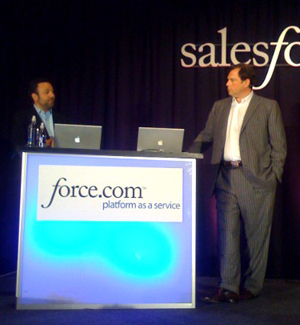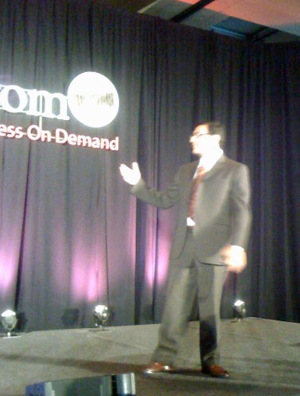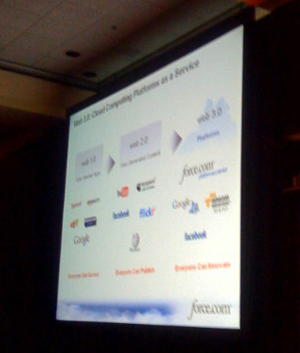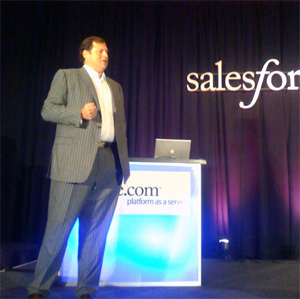
Steve Gillmor and I are at the Google and Salesforce announcement this morning, here in Santa Clara as part of Tour De Force. This morning we expect an announcement from Salesforce CEO Marc Benioff and VP of Engineering Vic Gundotra of Google. We will be live blogging the event starting at 10am PDT.
So what do we expect from the announcement today? We believe Google will integrate a Salesforce API client library into App Engine, to give developers a quick and easy platform for building Salesforce apps.
Post-Event Videos:
Steve Gillmor speaking with Marc Benioff:
http://qik.com/player.swf?streamname=9b88d76942234af6bd70372bac1b9c45&vid=111906&playback=false&polling=false&user=stevegillmor&userlock=true&islive=&username=anonymous
Steve Gillmor speaking with Vic Gundotra:
http://qik.com/player.swf?streamname=4fe352bb103c49c6b60489434442cac6&vid=111898&playback=false&polling=false&user=stevegillmor&userlock=true&islive=&username=anonymous
Live Notes:
12:01pm – Benioff wraps up the keynote by talking about the sessions that are being held during today and tomorrow – lots of in-depth tutorials and discussions about force.com, Apex, Google apps and a lot more. If you are a developer interested in learning more about force.com, have a look at the Salesforce website, you may be able to get a last-minute pass to the conference here.
12:00pm – The demos are done, lots of interesting features being displayed, but the key here is the new combined Google + Salesforce platform and how that will and can be used. Google is pushing their platform into the enterprise, and they are doing so via Salesforce and their hundreds of thousands of enterprise customers. We expect more announcements from Salesforce and Google in the near future, as each time they gather on stage it is getting more and more interesting.
11:56am – They have integrated Thomson financial data via an API and displayed graphs etc. (and mashed it with the Reuters new feeds) to provide a quick snapshot in a dashboard for wealth tracking. So on the dashboard there is an integration point with RSS feeds and the financial data API. They say that the integration was dead easy, and that Thomson Reuters is now able to offer their data licenses and applications to anybody because it is on force.com.
11:54am – Ok, so they do have a demo. It is a wealth management add-on for Salesforce. Marc is asking them questions about how they built their platform, who uses it etc. and integration points. So one integration point is pulling in news feeds (RSS feeds, not very hard).
11:52am – Thomson Reuters is now on stage – they also have demo applications. (correction: they are talking about something that they are building using force.com, a financial planning app). They say that the force.com platform is the right choice for them because of how easy it is to develop apps (ie the local Eclipse + Apex environment, sandbox, customizations with workflow etc.). They are also using VisualForce to build out the UI and making it consistent across the whole application – ie. Salesforce no longer has to look like Salesforce, so you can keep a standard interface to all your apps (hosted on force.com or not).
11:50am – More demos of the big API 3-way. The big take-away so far: Google is injecting its platform into the enterprise via Salesforce. See Marc Benioff’s comments below, when he talked about how Salesforce and Google have worked together, a lot of specific language around their goals.
11:47am – Empirio is showing a demo of what they built on force.com for Dolby Labs. The application is used to run theatres, and it displays an overview of various theatres, the screens they have and any problems that the screens may be experiencing. The Dolby users can pull up all the theatre data. When they click on movies out on a particular day, it brings it up in a calendar. This is just a real world demo of force.com + Google Apps and other API’s, the guys at Empirio are the integrators and developers, so he is just stepping through various features they built.
11:45am – Marc is introducing a local startup founder and CEO, the company is Empirio. They make a few SAP jokes and then talk about platform as a service.
11:43am – Like a televangelist, Benioff enters the audience and pulls a member out who worked with CODA on the sforce.com integration and asks her about how she found while working with force.com.
11:41am – Ok, so now they are going to demo everything together – CODA, Google and Salesforce. Accountants love spreadsheets, so with this integration they can use Google Spreadsheets (I think they love Excel actually, not all spreadsheets – but that will work itself out). In Google Spreadsheets, the user can use a sforce.com gadget (plugin) and then push the data back to force.com and CODA. The pieces are starting to fit together – office apps from Google, the platform from Salesforce along with the core business objects. Everything around that is provided by AppExchange apps and then customized further by developers using Apex.
11:40am – They’re now showing a demonstration of CODA integrated with Salesforce: there are API’s to everything again, so developers can tap the CODA API’s as well and write in Apex. They are displaying a simple demo where invoice items (from CODA) are being shown in Salesforce. This is the bit of the puzzle Salesforce really needed, and CODA has been available in AppExchange since DreamForce, but further API integration makes it a whole lot more useful.
11:36am – Back to Adam Gross now who is about to demonstrate the CODA build on force.com and the integration.
11:35am – CODA is aiming to do for accounting what Salesforce did for CRM. They estimated it would take them 2 years to build it all out (ie a saas platform). He said that it was a difficult investment to make, because they didn’t want to invest to build out the infrastructure, build the platform and they wanted to get to market quickly. So (surprise, surprise) they decided to integrate their application with Salesforce (well, build it on the Salesforce platform). CODA is not only sharing their application with Salesforce, but also the data – their users can then integrate from CODA into Salesforce.
11:33am – Marc is about to introduce CODA, the second-largest ERP provider in Europe. We are about to hear news of Salesforce filling out the platform with a finance and ERP solution from CODA. Jeremy Roche from CODA also made a joke about how short he is and how tall Mark Benioff is, just as Vic from Google did (almost the same joke actually).
11:31am – Marc is mentioning ERP, he is asking the audience who would like to see it.
11:30am – Adam is about to do another example using Google Spreadsheets. This demo is all live, he just dumped a quick contact record into a Google Spreadsheet and it was very quick and easy. I am starting to see all of these apps coming together (and we are still chewing on what Benioff said above about the Google relationship), but Google provides a big part of the platform that Salesforce doesn’t have, and vice-versa, so the relationship makes a lot of sense.
11:27am – They are querying and calling Google API’s, and binding them to events within Salesforce which fire off the Apex code. Very cool, he just whipped up some quick code that syncs Google Calendar with the internal Salesforce calendar.
 11:25am – Adam is demonstrating force.com and the new features. He is demonstrating how new objects and tabs are created from external metadata (over API’s). Adam is using Eclipse on his desktop (on a Mac) to build a quick Apex app using external API’s. He points out that the development environment isn’t running on his machine, everything is actually on Salesforce.com – Eclipse is just the IDE. He is pulling down data sets in XML from various services.
11:25am – Adam is demonstrating force.com and the new features. He is demonstrating how new objects and tabs are created from external metadata (over API’s). Adam is using Eclipse on his desktop (on a Mac) to build a quick Apex app using external API’s. He points out that the development environment isn’t running on his machine, everything is actually on Salesforce.com – Eclipse is just the IDE. He is pulling down data sets in XML from various services.
11:20am – Benioff is talking about the Google and Salesforce integration, he says: “You can now call the Google API’s from Apex code”, and continues with “…this is step 1 in total unification between force.com and all the exciting technology that Vic and his team are working on”, and “the ability to bring these platforms together is extremely important…Salesforce is bringing the Google platform into the enterprise.”
11:17am – Vic Gundotra just left the stage and didn’t go into any details about the new Google and Salesforce integration. We will get the protocol details later.
11:15am – Now we are onto API’s – Vic talking about Salesforce being built on standard Atom. Read and write through the Atom Publishing Protocol (APP, excellent). Google has been a strong advocate of APP, and it seems they have moved Salesforce into adopting it as a standard as well so that their apps can talk to each other.
 11:10am – Vic Gundotra is now on stage. Google also believes in software as a service, he says that they have worked together a lot with Salesforce, as they are both companies born on the web and share a lot in common in terms of beliefs. Vic is going back in time now – 30 years ago, talking about mainframes. Ok, so this is the three-generations: talk – mainframes, then client-server and then Saas and web platforms. Google spends $4B a year on co-lo capex (as opposed to the 300M Salesforce spends).
11:10am – Vic Gundotra is now on stage. Google also believes in software as a service, he says that they have worked together a lot with Salesforce, as they are both companies born on the web and share a lot in common in terms of beliefs. Vic is going back in time now – 30 years ago, talking about mainframes. Ok, so this is the three-generations: talk – mainframes, then client-server and then Saas and web platforms. Google spends $4B a year on co-lo capex (as opposed to the 300M Salesforce spends).
11:06am – Benioff is now talking about the Google relationship, referring to them as a strong ally. The first joint announcement between the two companies was back in 2003, when
google.org and the Salesforce foundation worked together with a combined grant. From there in 2005, the companies released their first mashup with maps, then AdWords integration in 2006, further API integration in 2007 and now Google App Engine in 2008.
11:03am – Benioff is pushing Eclipse as an IDE again – they seem to be assembling a whole development environment on Salesforce with everything from API’s to access code, the IDE, the dev sandbox and project collaboration. Don’t be surprised if we see more development tools hosted by Salesforce – such as a code repository, documentation (wiki’s?), and more (similar to code.google.com) – this could be a whole service on its own for other developers, but at the moment it seems to only
work for developers working on force.com apps.
11:01am – More stats: 1.5M Apex requests per day, it’s all live and not in beta. Apex is a framework where Salesforce hosts your code. It runs in a sandbox on their servers and allows a developer to directly query and customize Salesforce. VisualForce is a result of a Google Summer of Code project, it is a visual IDE to design user interfaces. Salesforce stores the user interface and can push it to any device. Now that VisualForce is live and out of beta, we will need to dig into it because
the details here at the moment are vague except that Salesforce can now host your UI code.
10:58am – I love statistics. Benioff touches on them briefly: 150M+ transactions a day, average speed of 210ms, $300M+ invested in servers. 2 fully mirrored data centers. Would love to hear more about the hardware behind salesforce (I believe they are still mostly running on Sun hardware, Solaris and with Oracle as the DB). All the uptime statistics are available on trust.salesforce.com (again an area that Salesforce was early in, being transparent on uptime and performance). There seems to be more details on the status site than there were before. There was an interesting announcement earlier this morning that is relevant to the Salesforce status page.
10:55am – – Benioff is back on stage now, talking further about force.com and the big sell: “It’s all about innovation, you can leave your infrastructure concerns behind…you can focus on the application you can build, you can focus on the value that you can build for your business” – this is all in reference to the new “platform as a service” and mashing up API’s.
10:52am – Fischer goes on to say that Salesforce spends a lot of time focusing on security, performance and compatibility. The security issues with Saas and web applications used to be a big adoption issue, back in 1999 – most organizations have overcome their nervousness about web applications and platforms, but security at both a code and server level, then an application level, is raised as an issue with most medium to large customers. Most internal IT groups also have personnel
focused exclusively on performance and uptime, so Fischer is giving the standard sell about the advantages of the multi-tenant model. I think almost all of the people in the room here today have already bought into this and are waiting to hear what’s next. Benioff asked earlier if anybody was here to hear about desktop or server apps, and a half-dozen or so people raised their hands – probably as a joke.
10:45am – Steve Fischer is up on stage now, he is head of platforms at Salesforce. He is talking about the key questions that come up when businesses are inquiring about what the best solution is for business needs (let me guess, the answer to both is Salesforce?). He is talking about the standard advantages of being in the cloud, ie. outsourced, no need for data centers etc. etc. We have all heard this many times. The next point is customization – not only through the Salesforce core platform, but also through mixing the Salesforce API with other API’s and the force.com platform. Fischer says the biggest question when deciding on a platform to use is which platform will prevail, and who will still be around in 10 years? The answer to that would be Salesforce as well.
10:40am – It is interesting to hear Salesforce talk about their platform in the context of Web 1.0/2.0/3.0 – they see that they have or are representing the cutting edge of each of these phases. During web 1.0, Salesforce was a web-based CRM app. During web 2.0, we saw Salesforce develop sforce.com and mashups and now with what they refer to as Web 3.0 they now talk about force.com and platforms as a service. So Salesforce went from salesforce.com to sforce.com and now to force.com – so I guess web 4.0 will be orce.com ?
 10:35am – A really big push here about “platform as a service.” There is an image up on the screen of web 1.0, merging to web 2.0 and then merging and progressing into web 3.0. So according to Benioff, web 1.0 was about the killer internet applications – such as Yahoo, Amazon, eBay and the “old” Salesforce. Web 2.0 is about user generated content – YouTube, MySpace, facebook, flickr etc. and now with Web 3.0 he says that “something big is definitely happening,” with cloud computing and platforms as a service – he cites force.com, Facebook, AWS and the Google App Engine.
10:35am – A really big push here about “platform as a service.” There is an image up on the screen of web 1.0, merging to web 2.0 and then merging and progressing into web 3.0. So according to Benioff, web 1.0 was about the killer internet applications – such as Yahoo, Amazon, eBay and the “old” Salesforce. Web 2.0 is about user generated content – YouTube, MySpace, facebook, flickr etc. and now with Web 3.0 he says that “something big is definitely happening,” with cloud computing and platforms as a service – he cites force.com, Facebook, AWS and the Google App Engine.
10:32am – He runs through the financials of the company quickly, the stock has rocketed recently. Salesforce is reaching $1B in revenue for 2008, 50% growth – the market cap is now bigger than Sun‘s (8.75B) which quiet an achievement.
10:31am – Benioff is talking about the Salesforce charity initiative. They pioneered the “1 percent” model that many other startups and companies are now using. Marc said that in the early days this was easy to do, because Salesforce had “no time, no equity and no product”. Many charities are represented in the audience, they seem to be a big user block.
10:29am – Marc is talking about the Salesforce “Summer 08” release and about some of the new features. It is interesting that Salesforce was the first web company to introduce version numbers and releases for web software, which is definitely an old software model (along with “upgrades”). It seems to
work very well as they package their marketing and conferences around these releases.
10:26am – Whether Salesforce is building an application for a specific purpose or not, because of the platform and API’s anything and everything can be customized. Salesforce is really pushing this message hard this morning – they want companies mashing up their own API’s with others. This pitch is to both the app providers and the customers.
 10:22am – In traditional enterprise software, small, medium and large companies are separated in terms of the software they use. With the Saas approach and platform approach that Salesforce has deployed, companies of all sizes are using the same service. “This is the power of multi-tenant software” says Benioff.
10:22am – In traditional enterprise software, small, medium and large companies are separated in terms of the software they use. With the Saas approach and platform approach that Salesforce has deployed, companies of all sizes are using the same service. “This is the power of multi-tenant software” says Benioff.
10:19am – This has been the Salesforce story for over 8 years now, and they pioneered much of what we refer to as Saas today with their web-based “no software” approach.
10:17am – Marc Benioff is now out on stage, running 17 minutes late as we waited for all the attendees to enter the large conference room here at the Hyatt in Santa Clara. He is introducing today’s event by talking about the evolution of computing – from the mainframe model, to the client-server model and now to the Saas/web model.